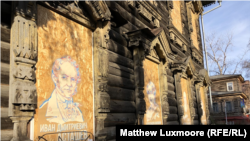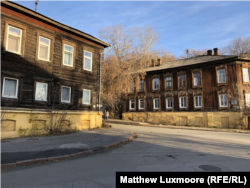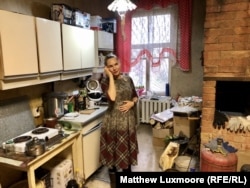TOMSK, Russia -- Aleksandr Belikov, the owner of a toy business, recalls driving past the old wooden house on Pushkina Street and lamenting the sorry state it was in.
Its windows boarded up and its roof charred by a 2012 fire, the building dating to the turn of the 20th century was slowly sinking into the ground. Like much of Tomsk’s architecture, it had seen far better days.
Belikov, a Tomsk native, decided to save it. With help from a newly launched regional government program called Rent For A Ruble, he got planning permission to fix up the house, spending some 10 million rubles ($132,400) on the project.
He now pays a symbolic rent to the state and is free to use the building as he chooses. "I wanted to see it return to its former glory," he says.
Rent For A Ruble
The Rent For A Ruble program is one of several initiatives championed by conversationists to save the historical legacy of this 400-year-old city in Siberia and thwart efforts to erase its unique architecture for lucrative new real estate.
On side streets throughout this bustling Russian city, with a population of just over half a million people, you find unexpected gems: century-old wooden buildings that range in condition from pristine to crumbling.
After the Russian Revolution in 1917, which toppled the monarchy, the communist government took over the wooden houses. Many hosted multiple families in communal apartment that strained the homes' capacity. Then came the Soviet collapse in 1991, and dozens were razed to make space for supermarkets or high-rise office blocks.
Some 1,800 of the wooden houses remain, but their number continues to shrink.
"We're losing more and more examples of our historic wooden architecture," said Maria Bokova, who heads the Tomsk branch of Russia's Society for the Preservation of Historical and Cultural Monuments. "And we're losing our history in the process."
Bokova estimates that more than 100 old wooden houses have been demolished in the past decade alone, and at least 50 are in critical condition. The city's oldest building, which some historians date to the 17th century, is on the verge of collapse. Its elderly inhabitants died two years ago and the new owners reportedly rebuffed an offer from a major investor. Better offers will come, Bokova suspects.
Initiatives like Rent For A Ruble have helped resuscitate a small proportion of the homes. As part of the deal, developers like Belikov pay 1 ruble (about 1 U.S. cent) rent per square meter for 49 years following their restoration work.
An annual architecture gathering, called the Tomsk Sawyer Festival, brings together volunteers for restoration. But money is tight and interest limited, says festival founder Andrei Ivanov. Despite benefitting from federal grants, he and his team have restored only three homes since 2017, spending an average of $3,000 on each.
In the mid-2000s, the city launched a partnership with the Department of Architecture at the Karlsruhe Institute of Technology in Germany, whose professors have visited Tomsk several times to appraise the wooden homes and aid restorative work. They concluded that many of the buildings had the potential to stand another 300 years, testament to the longevity of wood as a building material.
Political Battle
But a political standoff is stymieing conservation efforts. As activists push to restore endangered houses, there's a parallel campaign by some city officials to authorize free use of the city center -- potentially stripping the old houses of state protection.
The question of how, and whether, to preserve the city's historic facade has pitted two groups against each other. Conservationists argue that the wooden buildings are a core part of Tomsk's identity; their opponents say the houses are often not fit for habitation, and many are beyond repair.
A special point of contention is the demarcation of a protected zone in the city center. Efforts to decide on the borders of such an area received a boost in January 2019, when Russian President Vladimir Putin responded to an appeal from Tomsk's conservationists and instructed city officials to strike an agreement by that May.
But the eventual blueprint was rejected by conservationists as too lenient, and the months since have seen heated debates in local government bodies and advisory councils, with the proposal undergoing multiple revisions and no deal forthcoming. The longer the process drags on, activists fear, the more houses will be lost.
"If we're lucky enough to live in a city like this, why don't we come together and do something?" says Bokova, who lives in a wooden building built in 1895. "It's our duty."
Some locals also acknowledge that there's a limit to what the state can do, and say there's too little coordination among Tomsk residents who are keen to preserve their architectural legacy.
"Seventy years of Soviet rule have caused us to unlearn self-reliance. We believe the state should do everything for us," says Elina Mikhaltsova, a 27-year-old tour guide and translator. "But everything depends on us. Start with something small, and work from there."
Mikhaltsova lives with her father, Sergei, in a large wooden house north of the city center that opened as a school in February 1905 and turned into a branch of a Soviet paramilitary sport organization in the 1970s.
The school's name and the date it first opened its doors -- on the 50th anniversary of Tsar Nicholas I's death -- are just discernible from the faded lettering above its old entrance.
Mikhaltsova wants her spacious house to once again become a school one day, or a gathering place for the local community. "I want to open the eyes of Tomsk residents to their history," she says. "We know too little about our city."
Last summer, as Belikov's restoration work drew to a close, he unearthed documents in the local archives showing that the building on Pushkina Street was originally a teahouse serving travelers on the Great Siberian Tea Road, which ran through Tomsk and was used to transport tea from China to Europe.
The discovery inspired Belikov to open a new teahouse on the premises, set to launch once coronavirus restrictions lift. Despite the danger to Tomsk's legacy from inadequate protection and the passage of time, he's optimistic the city's unique architecture can be saved.
"I'm not losing hope. The fewer houses remain, the more attention they're getting," he says.
In the meantime, he's restoring two adjacent homes in another part of Tomsk, slated for completion by 2023. He says "the other houses will get their turn."
















